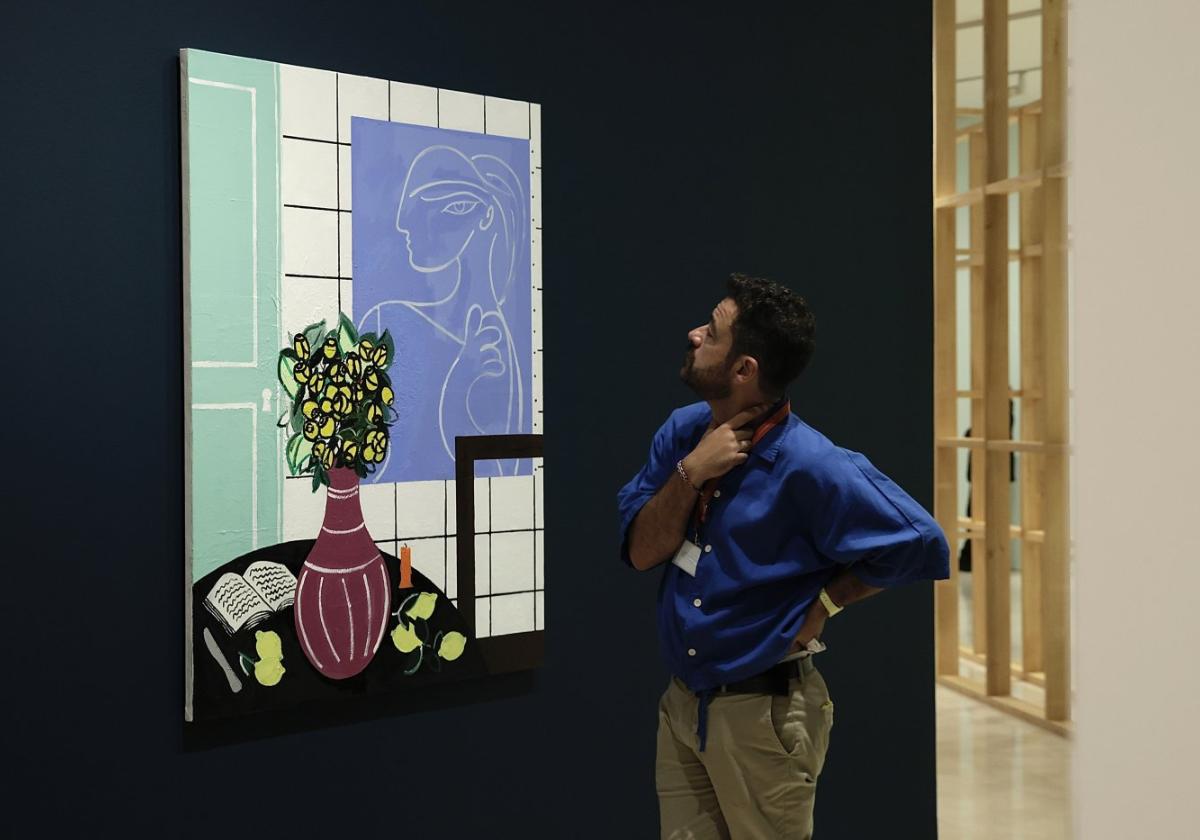Beyond Pablo
"Dream On" at the Picasso Museum
Georgina Oliver
Friday, 8 August 2025, 12:37
Pablo Picasso's Las Meninas series echoing Velázquez's 1656 masterpiece paved the way for present-day visual meme and musical sample culture. In a similar vein, the sampling of sound fragments and lyrics fundamental to hip-hop (of which Eminem's 2003 song, Sing for the Moment, revisiting Aerosmith's 1978 rock hit Dream On, is an eminent example...) has influenced contemporary art.
Two temporary exhibitions featured at the Fundación Museo Picasso Málaga are an invitation to meditate upon the invisible loops linking Surrealism and modern art-infused post-conceptual painting. One spotlights a prominent Spanish member of the International Surrealist Movement, Óscar Domínguez (Tenerife, 1906-Paris 1957), while the other is a one-woman show entitled "Farah Atassi - Genius Loci": an allusion to a Latin expression meaning "the spirit of the place". In this case, the Roman 'deity' in attendance is Pablo Ruiz Picasso, whose spirit lives on via Atassi's work.
Genius Loci
Remixing images comes naturally to Farah Atassi. Belgian-born with Syrian roots, a Paris Beaux-Arts graduate, the recipient of several US university accolades, this 44-year-old mainstreamer sprinkles her replies to interviews with transatlantic buzzwords, even when they are conducted in French.
More often than not tributes to Picasso, jazzed up with a dash of geometric playfulness reminiscent of the funky Milan-based 1980s Memphis design group, her compositions (which she prefers to describe as "stages", "sets" or "displays") incorporate quirky cubist "patterns", "grids" and "cuts" à la Matisse, spliced from other modern masters such as Fernand Léger and Georges Braque, as well as slinky-dreamy reclining female figures.
Farah paints about painting, each of her canvases resuming the underpinnings of the studio experience. If she were a fashion designer her hero would most certainly be Yves Saint Laurent (for his Mondrian dresses), and she would probably be into upcycling: bringing a fresh twist to remnants of trends past and present.
The grand finale of the show is a Mechanical Ballet dated 2024 in which women and objects, legs and abstract curvilinear shapes, partake in a Moulin Rouge-esque performance. The stuff of the artist's Modernist dreams.
Surrealist dreamer
Not as much of a household name as Dalí or Miró, Domínguez was by all accounts a "loose cannon", who let his imagination run wild, both on canvas and beyond, often raising havoc at Surrealist gatherings in Paris, which became his permanent home, following the outbreak of the Civil War in his native Spain.
Born in the Canary Islands, to an affluent family of plantation owners, young Óscar should have basked in a golden childhood, but this dream collapsed when he contracted a severe illness, which affected his bones, curtailing his growth and deforming his limbs and facial features. Under the wing of a caring grandmother, he began to paint at an early age, partly to take his mind off this real-life nightmare.
Children of the digital age think nothing of diving into an image bank with a view to conjuring up other-worldly settings peopled by hybrid monsters - devil-may-care, compared to those trailblazing Surrealist dreamers who delved into the depths of their unconscious, haunted by the horrors of the First World War. Virtual creativity has supplanted the teenage collage.
Painter-dreamster, sculptor, photographer, commercial and graphic artist, tapestry and textile designer, Óscar Domínguez, had to seek inspiration in his mind's eye. It takes more than "a click or two" to depict a nocturnal vision or mental obsession on canvas, to construct purposeless machines in a flight of fantasy, or to perfect the decalcomania transfer technique, as this tortured spirit did. Cause of death: suicide. The fulfilment of a premonition? At the age of 25, he had painted a self-portrait featuring a distorted hand and arm, with slashed veins...
On the same planet
What common ground is there between this angst-ridden universe and "Planet Atassi"? First and foremost, a mutual admiration for Picasso. In 1941, Domínguez executed a further portrait of himself, as a Picassian bull. Secondly, a tendency to display subjects against a geometrical backdrop. In 1935, he represented a couple of imaginary equestrian creatures (both horses: one two-headed, the other headless) in a theatre-like context. Thirdly, the ability to create eye-catching juxtapositions, blurring the frontiers between the living and the inanimate; indoor and outdoor; sea, sky and Earth... In the late 1930s, he embarked on a "Flying Saucer" period.
Oh, and, on a more frivolous note... a propensity to move around in the higher spheres of the art world. Part Quasimodo, part Beau Brummell, "don Óscar" had a long-term affair with a flamboyant French "Vicomtesse": Marie-Laure de Noailles, a patron of the avant-garde, who nicknamed her lover "Putchie".

Comentar es una ventaja exclusiva para registrados
¿Ya eres registrado?
Inicia sesiónNecesitas ser suscriptor para poder responder.
Necesitas ser suscriptor para poder votar.